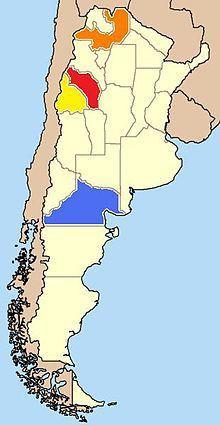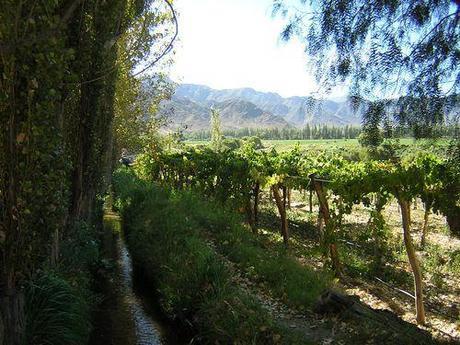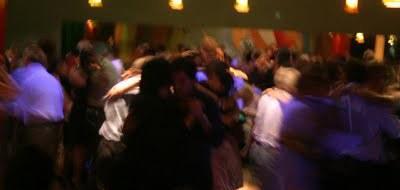Torrontés is a white Argentine wine grape varietal, producing fresh, highly aromatic wines (notably peach and apricot) with moderate acidity, and smooth texture and mouthfeel. There are three Torrontés varieties in Argentina: Torrontés Riojano, grown in La Rioja, is the most common. The other two are Torrontés Sanjuanino, from San Juan, and Torrontés Mendocino, from Rio Negro (Mendocino refers to Mendoza). It is mainly Torrontés Riojano that is used for most Argentine Torrontés.

Map highlighting regions where Torrontés is grown
All three Argentine Torrontés varieties belong to the Criollas group of grape varieties, which is a term used for presumably American-born cultivars the European grapevine Vitis vinifera. The three grapes are relatively similar but do have some noticeable differences. DNA profiling shows that Torrontés Riojano and Torrontés Sanjuanino are separate crossings of Mission and Muscat of Alexandria. Torrontés Mendocino is probably a crossing of Muscat of Alexandria and another, so far unidentified, grape variety.
Torrontés Riojano is the most aromatic and most planted of the three, with aromas reminiscent of Muscat and Gewurtztraminer wines. Torrontés Riojano and Torrontés Sanjuanino both tend to have large loose bunches of pale grapes while Torrontés Mendocino, however, has smaller, tighter bunches of darker yellow grapes. The least aromatic, and least widely planted, is Torrontés Mendocino with the aromatics and plantings of Torrontés Sanjuanino in between.
Around 8,700 hectares (21,000 acres) in Argentina have been planted with Torrontés Riojano, and 4,850 hectares (12,000 acres) with Torrontés Sanjuanino. Plantings in the very high altitudes (1700m+) of the Calchaquíes Valleys in the far north of Argentina have recently met with success. The vine is highly productive and is just under ten percent of all white grape plantings, however as a varietal, it made up almost 20 percent of all white wine sold in Argentina in 2008. The Salta region in northwest Argentina, with the highest elevation vineyards in the world at 4200-9842 feet, is particularly noted for its Torrontés, because the grape thrives in cold, dry, windswept conditions.

A vineyard in Salta
Finally, Torrontés is responsible for more than one really fun evening I’ve had in Buenos Aires!

A milonga at El Beso, Buenos Aires
Wine Notes
I attended a tasting of Torrontés in San Francisco sponsored by Vine Connections. It featured six different Torrontés, paired with fabulous empanaditas from El Porteño in the Ferry Building. I liked five of the wines, each for different reasons.
Torrontés does not age well, and should be drunk within a year (or at most, two) of bottling.
Finca Las Nubes Torrontés 2011
Vineyard location: Valle de Cafayate (Salta)
The winery gets its name because it is at high enough elevation that on some days it is literally in the clouds.
Winemaker: José Luis Mounier
No oak, light fining, light filtration.
Alcohol: 13.5%
Intense nose, light on the palate. Fragrant and balanced. White flowers on the nose and dry melon on the palate.
Surprisingly long finish.
Crios Torrontés 2011
Vineyard locations: La Rioja, Tucumán, Mendoza
Winemaker: José Lovaglio (son of Susana Balbo)
No oak, no fining, light filtration
Alcohol: 13.8%
Nose: peach, honeydew, white flowers, sweet citrus
Palate: fruity yet dry, good acidity
Hermanos Torrontés 2011
Vineyard location: Cafayate (Salta)
Winemakers: Osvaldo, Gabriel & Rafael Domingo (brothers – thus the name of the wine)
No oak, light fining, light filtration
Alcohol: 14%
Nose: lemon zest, light fruit and freshly-mown grass
Palate: very light and crisp, refreshing
Coquena Torrontés 2010
Coquena is a mythical figure, an elf who is keeper of the vicuñes. He travels at night fiercely protecting his animals against anyone who tries to do them harm.
Vineyard location: Tolombón (Salta)
Winemaker: Marcos Etchart
No oak, light fining, light filtration
Alcohol: 13.8%
Nose: lemon peel, sweet citrus
Palate: minerality and great acidity, rich, long finish
Recuerdo Torrontés 2011
Vineyard location: Valle de Famatina (La Rioja)
Winemaker: Pablo Martorell
Consulting Winemaker: Santiago Achával
No oak
Alcohol: 13%
Nose: citrus and white flowers
Palate: tropical fruit, minerality, good acidity
